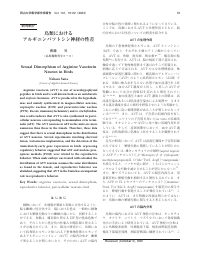

Scientific Reports of the Faculty of Agriculture, Okayama University
Published by the Faculty of Agriculture, Okayama UniversityONLINE ISSN : 2186-7755
Permalink : https://ousar.lib.okayama-u.ac.jp/64347
Sexual Dimorphism of Arginine Vasotocin Neuron in Birds
Saito, Noboru
Course of Applied Animal Science
Published Date
2023-02-01
Abstract
Arginine vasotocin (AVT) is one of neurohypophysial peptides in birds and is well known both as an antidiuretic and oxytocic hormone. AVT is produced in the hypothalamus and mainly synthesized in magnocellular neurons, supraoptic nucleus (SON) and paraventricular nucleus (PVN). Recent, immunocytochemistry and in situ hybridization results indicate that AVT is also synthesized in parvocellular neurons corresponding to mammalian stria terminalis (nST). The AVT neurons in nST in the male are more numerous than those in the female. Therefore, these data suggest that there is sexual dimorphism in the distribution of AVT neurons. Several experiments involving electrical lesion, testosterone implantation, and the detection of the immediately-early gene expression in birds expressing copulatory behavior suggested that nST and nucleus praeopticus medialis (POM) were related to the reproductive behavior. When male embryo was treated with estradiol, the distribution of AVT neurons assumes the same distribution as found in the female, and reproductive behavior was abolished, suggesting that AVT in the brain has an important role in reproductive behavior.
Keywords
arginine vasotocin
sexual dimorphism
reproductive behavior
parvocellular neurons
bird
Note
研究紹介 (Research Report)
ISSN
2186-7755
